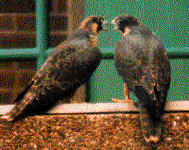Peregrine Falcon


There are a number of species of falcons, 5 in Canada. They are distinguished from other birds of prey by a toothlike bit like an egg-tooth near the tip of the upper-half of the beak. Smaller than hawks, they have small heads, tight feathers and long pointed wings- which lets them to fly really fast. When they are flying, they use quick, powerful wing strokes. Their strong, hooked beak and powerful taloned feet make the falcons a highly specialized predators.
The peregrine is a steady crow-sized falcon. In all falcons, the female (called the "falcon" by falconers) is bigger than the male (called the "tiercel") Adult males are 38-46 cm long and weigh about 570 g, while females are 46-54 cm and weigh about 910 g. The easiest features of the peregrine are the blackish malar stripe, or "moustache", below the eye and the dark bluish-gray or slate- coloured head, back, and upper part of the wings. The throat is white and the upper parts are white to buff, stomach or abdomen, under the wings, and the lower breast area.
The eggs are a brown colour that look like ping-pong balls. But if they are effected by DDT, a kind of pesticide, they are smaller, an yellowish- orange colour and thereís no shell, which makes the egg high at risk for not surviving. They are laid one every second day. Both adults sit on or incubate the eggs when the last or second- last eggs are laid. They have to sit on the eggs for 32 days. The chicks are called eyases. The average number of chicks is 2.5 in one nest and the average number successfully gaining flight (or fledging) is about 1.5
When the chicks hatch, they are blind for the first few days. They look like little cotton balls because of their white feathers or down. The parents take turns feeding them. Pretty soon, they will grow to the size of their parents. The feathers start changing from down to mature adult feathers in a few months. During their growing, the parents teach them skills to make them successful falcons, so they give them whole animals to swallow and half- dead prey to kill.
The prey varies greatly from region to region and even one nesting site to the next. In British Columbia, peregrines usually feed on the Murrelet, a small seabird nesting in the thousands. In Labrador, they hunt on Black Guillemots, another common seabird, and small mammals ( mice and voles ). At Rankin Inlet, on the west shore of Hudsonís Bay, peregrines eat mostly lemmings and shorebirds. In southern Canada, peregrines eat a variety of birds that live in wetlands, including Franklin Gulls, Black Terns, Lesser Yellowlegs, Eared Grebes, Common Flickers, Green- winged Teal, and Sora. In cities, peregrines do eat some pigeons, but these rarely account for more than 20% of their diet.
DDT is a pesticide that farmers use on their crops. Usually, mice and others like wild birds eat the plants that have DDT on it but donít get infected because it is a small dose and the animals can handle it. But when the peregrine falcon eats a lot of mice or animals that were eating the plants with pesticide, the peregrine gets infected. It doesnít do anything to the falcon but it does infect the eggs it produces. Thatís how the eggs turn orange and have no shell.